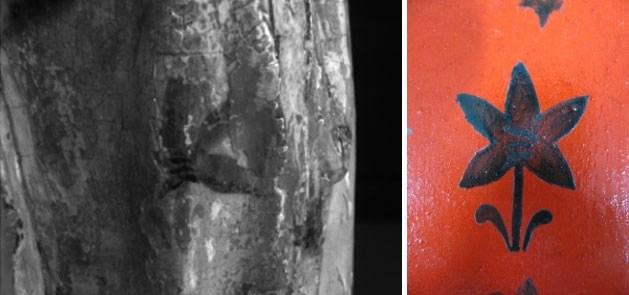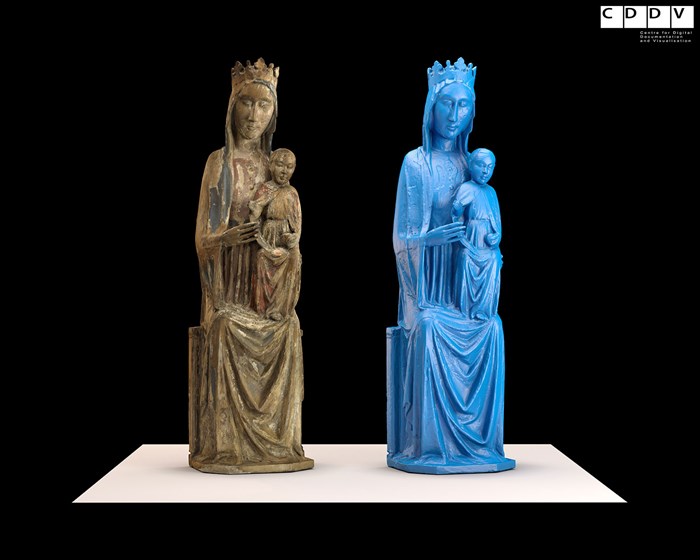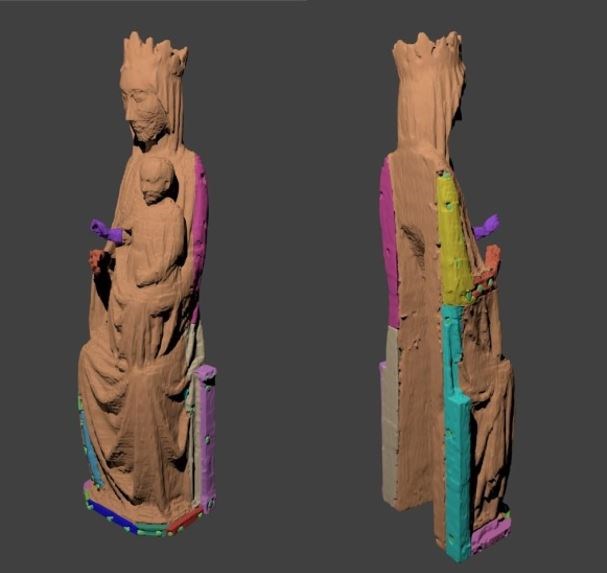Key in a search term below to search our website.
Key in a search term below to search our website.

The next step of the research process was to use the results of the paint investigations to produce a colour 3D digital model of the sculpture as it looked in the mid-1300s, and to show its changing appearance over the centuries.
We collaborated with Dr Mark Richter lecturer in technical art history at the University of Glasgow. Working with a Technical Art History student on her Master’s dissertation, we prepared sample boards using the materials revealed through scientific analysis in phase one of the project. She researched the techniques and recipes required to make the paints and made these up in the lab. We then painted out sample boards using these materials and techniques.

Grinding Verdigris (left) and sample boards painted out with seven coats of gesso followed by pigments and metallic foils.
Traces of original decorative detail are evident on the surface of the sculpture in places and the cross-section data supported this with combinations of metal foils and glazes. However, despite the clues for several areas, we had no concrete evidence of how this decoration may have looked. With the help of Helen Wyld, Senior Curator of Historic Textiles at National Museums Scotland, we looked for cross-references in contemporaneous panel painting. Choosing simplified designs to avoid too much fanciful make believe, we selected various patterns for the neckline of the Virgin’s tunic and the Christ child’s cloak. We were lucky in that the pattern on the Child's cloak could be seen clearly with Infrared Reflectography, so this pattern could be copied.

Infrared Reflectography showing an image of the flower pattern on Christ’s robe (left) and the painted out version on sample board.
In phase one of the project, Glasgow School of Simulation and Visualisation or SimVis had made a 3D structured light scan of the Madonna and Child. We now commissioned the use of this to make a 3D colour-rendered model. We wanted to be able to show the construction of the wood, the under-drawing, the preparation layers and the polychrome surface.
To achieve this, SimVis combined their model with a model of the wooden core created using the CT scan data by Tom Challands of Edinburgh University. The result is an animation showing the sculpture in the round, starting with the carved wooden elements assembled with nails (from the CT data), then the marking in of the underdrawing, the coating of white calcium sulphate preparation layer or ‘gesso’, followed lastly by the polychrome surface including impressions of the brocaded surface. Areas for which there was not enough polychromy data were left wood-coloured in the model. Equally, for the skin tones, where recreating the subtleties of a textured tonal painted surface would be particularly difficult, we decided to leave wood-coloured.

Structured light scan with surface rendered to match the current appearance on the left.

Coloured rendered model made from CT data depicting the construction elements of the statue: the main trunk with wooden additions and the nails, indicated in green.